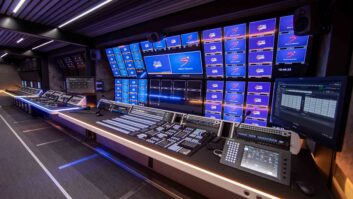
The editorial decisions behind current 2D live sports production need to be compromised if 3D broadcast costs are to be reduced says 3Ality Digital CEO, Steve Schklair, writes Adrian Pennington.
There’s a pressing need is to bring costs down for live sports and that requires simultaneous 2D and 3D productions, experimentation for which will happen this year, Schklair told TVB Europe.
“Everyone talks about the creative differences between 2D and 3D as being a barrier to simultaneous productions but I’ve never seen a 2D cut of anything shot in 3D that didn’t work,” he says. “Simultaneous productions will be an experiment this year. It won’t be used on a Golf Masters or a Super Bowl – no-one will compromise those events. But compromise is the only way forward for regular weekday sports.”
Schklair, whose rigs are used by EPSN and BSkyB, says that the editorial pace of 2D needs to be slowed and the number of camera angles needs reducing in order to make simultaneous productions work.
“The audience has been trained by the broadcaster over a decade to accept more cameras and angles. So it’s about training the audience back the other way,” he says. “With some adjustment the 3D would be perfectly viewable as 2D. Yes there would be some compromise on the 2D and the 3D editorial but TV is a business of compromise. It’s great to be a purist but the economic reality means it won’t work. You can be a purist right up till it’s not a business.”
US studios have discussed shooting 3DTV series with 3Ality, Schklair said.
“The important factor regards episodic TV is that you can now do 3D sets up to the same schedule as 2D,” Schklair said. “One thing is unchangeable on episodic and that is the schedule. Whereas you can add maybe add two to three weeks to the schedule for a feature you have two weeks to shoot a one hour show and that’s it.”
The R&D focus for the company includes graphics handling tools for 3D broadcasts and lighter-weight rigs and recording media aimed at the run and gun documentary production.
“We are also working on eliminating the ten extra crew members or technicans, that you currently need when doing a ten camera 3D shoot. It’s not just ten people on salary – but ten airfares, ten times food, hotel, accreditation and space in a broadcast compound. That’s a lot of extra expense which we can reduce by automating some of the process.”
3Ality Digital equipment can be rented and serviced in the UK via Arri Media in a deal signed at the end of last year. The company is also to open a training division for its equipment in the UK, Schklair revealed.
Its equipment is currently being deployed on two major Hollywood features: Peter Jackson’s The Hobbit and Spider-Man 4, both being shot with Red Epic cameras.
The editorial decisions behind current 2D live sports production need to be compromised if 3D broadcast costs are to be reduced says 3Ality Digital CEO, Steve Schklair, writes Adrian Pennington.
There’s a pressing need is to bring costs down for live sports and that requires simultaneous 2D and 3D productions, experimentation for which will happen this year, Schklair told TVB Europe.
“Everyone talks about the creative differences between 2D and 3D as being a barrier to simultaneous productions but I’ve never seen a 2D cut of anything shot in 3D that didn’t work,” he says. “Simultaneous productions will be an experiment this year. It won’t be used on a Golf Masters or a Super Bowl – no-one will compromise those events. But compromise is the only way forward for regular weekday sports.”
Schklair, whose rigs are used by EPSN and BSkyB, says that the editorial pace of 2D needs to be slowed and the number of camera angles needs reducing in order to make simultaneous productions work.
“The audience has been trained by the broadcaster over a decade to accept more cameras and angles. So it’s about training the audience back the other way,” he says. “With some adjustment the 3D would be perfectly viewable as 2D. Yes there would be some compromise on the 2D and the 3D editorial but TV is a business of compromise. It’s great to be a purist but the economic reality means it won’t work. You can be a purist right up till it’s not a business.”
US studios have discussed shooting 3DTV series with 3Ality, Schklair said.
“The important factor regards episodic TV is that you can now do 3D sets up to the same schedule as 2D,” Schklair said. “One thing is unchangeable on episodic and that is the schedule. Whereas you can add maybe add two to three weeks to the schedule for a feature you have two weeks to shoot a one hour show and that’s it.”
The R&D focus for the company includes graphics handling tools for 3D broadcasts and lighter-weight rigs and recording media aimed at the run and gun documentary production.
“We are also working on eliminating the ten extra crew members or technicans, that you currently need when doing a ten camera 3D shoot. It’s not just ten people on salary – but ten airfares, ten times food, hotel, accreditation and space in a broadcast compound. That’s a lot of extra expense which we can reduce by automating some of the process.”
3Ality Digital equipment can be rented and serviced in the UK via Arri Media in a deal signed at the end of last year. The company is also to open a training division for its equipment in the UK, Schklair revealed.
Its equipment is currently being deployed on two major Hollywood features: Peter Jackson’s The Hobbit and Spider-Man 4, both being shot with Red Epic cameras.






